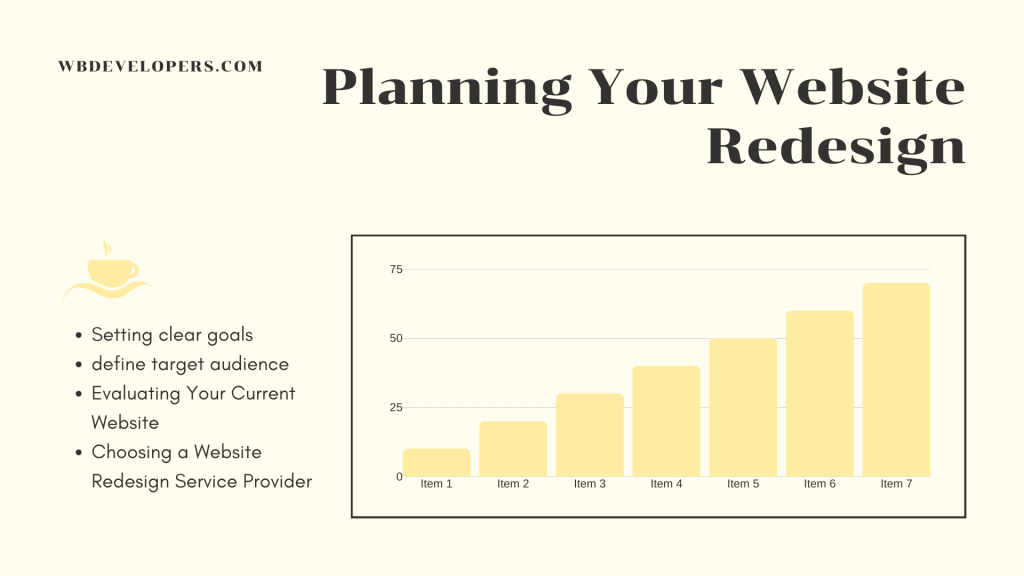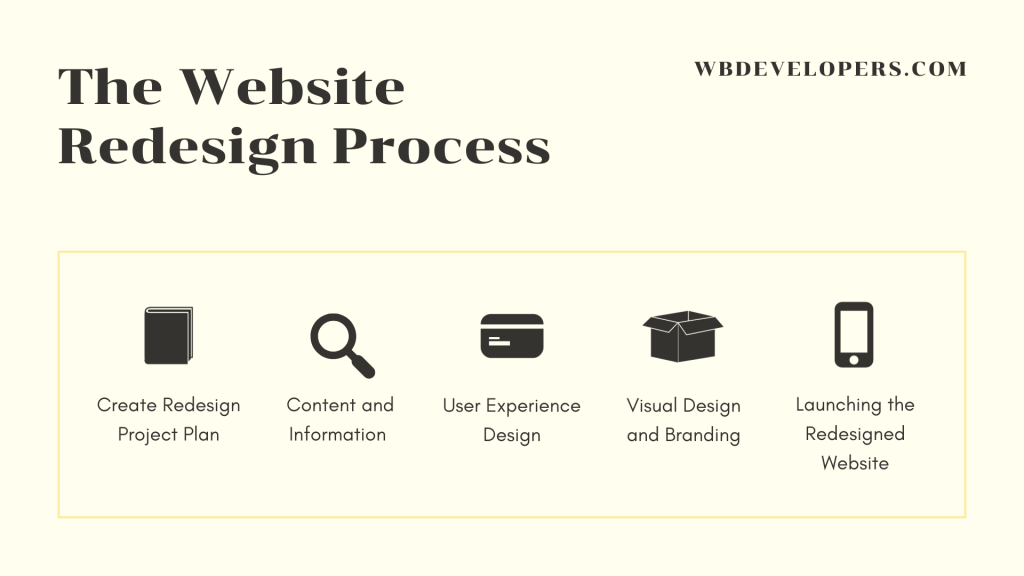
Introduction to Website Redesign Services
Why Website Redesign Matters
In today’s digital landscape, your website serves as the face of your business. It’s often the first interaction potential customers have with your brand. A visually appealing and user-friendly website can create a positive impression, driving engagement, and conversions. On the other hand, an outdated or poorly designed website can lead to high bounce rates and lost opportunities.
Website redesign services offer a solution to transform your website into a modern, functional, and visually appealing platform that engages visitors and encourages them to take action. Whether your website needs a complete overhaul or minor tweaks, a professional redesign can help you achieve your business goals and stay ahead of the competition.
Benefits of Website Redesign
Website redesign services offer numerous benefits for businesses of all sizes and industries. Let’s explore some of the key advantages you can expect from a well-executed website redesign:
- Enhanced User Experience: A website redesign allows you to optimize the user experience by improving navigation, simplifying the layout, and making it easier for visitors to find the information they need. A positive user experience can lead to increased engagement, longer time spent on the site, and higher conversion rates.
- Improved Branding and Visual Appeal: A website redesign provides an opportunity to update your branding, incorporate new design trends, and create a cohesive visual identity that represents your brand effectively. A fresh and visually appealing website can help build trust, establish credibility, and leave a lasting impression on visitors.
- Mobile Responsiveness: With the increasing use of mobile devices, having a mobile-responsive website is crucial. A website redesign can ensure that your site looks and functions seamlessly across all devices, providing a consistent user experience and improving your search engine rankings.
- Search Engine Optimization (SEO): A website redesign allows you to optimize your site’s structure, content, and technical elements for better search engine visibility. By implementing SEO best practices during the redesign process, you can improve your website’s organic rankings, drive more targeted traffic, and increase your online visibility.
- Integration of New Features and Functionality: As technology evolves, new features and functionality become available to enhance the user experience. A website redesign enables you to integrate these new elements into your site, such as interactive forms, live chat, social media integration, e-commerce capabilities, and more.
These are just a few examples of the benefits you can gain from a website redesign. The specific advantages will vary depending on your business goals, target audience, and industry.
Planning Your Website Redesign
Before diving into the website redesign process, it’s essential to have a clear plan in place. Proper planning will help you set realistic goals, define your target audience, evaluate your current website, and establish a roadmap for the redesign. Let’s explore these key planning steps in detail.
Setting Clear Goals for the Redesign
The first step in planning a website redesign is to define your goals. What do you hope to achieve with the redesign? Are you looking to increase conversions, improve user experience, boost search engine rankings, or enhance your branding? Clearly identifying your goals will help guide the entire redesign process and ensure that it aligns with your business objectives.
Consider setting SMART goals for your website redesign:
- Specific: Clearly define what you want to achieve with the redesign. For example, increase conversion rates by 20% or reduce bounce rates by 10%.
- Measurable: Identify specific metrics or key performance indicators (KPIs) that will allow you to track the success of your redesign. This could include metrics like conversion rates, bounce rates, time on site, or search engine rankings.
- Achievable: Set realistic goals that are attainable within your resources, budget, and timeline.
- Relevant: Ensure that your goals are aligned with your overall business objectives and will have a positive impact on your bottom line.
- Time-bound: Set a timeline for achieving your goals. This will help keep the redesign process on track and ensure that you’re making progress towards your objectives.
By setting clear and measurable goals, you can track the success of your website redesign and make data-driven decisions throughout the process.

Defining Your Target Audience
Understanding your target audience is crucial for designing a website that resonates with your users and meets their needs. Take the time to define your ideal customer profile, considering factors such as demographics, psychographics, and user behavior.
Start by creating buyer personas, which are fictional representations of your ideal customers. These personas should capture key information about your target audience, including their age, gender, location, interests, pain points, and motivations. The more detailed and accurate your personas are, the better you can tailor your website redesign to meet their specific needs and preferences.
Additionally, consider conducting user research and gathering feedback from your existing customers. This can provide valuable insights into their preferences, expectations, and pain points when interacting with your website. By understanding your target audience, you can design a website that caters to their needs, improves their experience, and increases the likelihood of conversion.
Evaluating Your Current Website
Before embarking on a website redesign, it’s essential to evaluate the strengths and weaknesses of your current website. This evaluation will help you identify areas that need improvement, determine what elements to retain, and set a benchmark for measuring the success of the redesign.
Start by conducting a comprehensive website audit, analyzing various aspects of your site, including design, functionality, content, navigation, and user experience. Consider the following questions:
- What aspects of your current website are performing well and should be retained in the redesign?
- What elements of your website are not meeting your expectations or user needs and should be improved or removed?
- Are there any technical issues, such as slow loading times or broken links, that need to be addressed?
- How well does your current website align with your branding and overall business goals?
- Is your website optimized for search engines, and are you ranking well for relevant keywords?
By evaluating your current website, you can identify areas for improvement and develop a clear roadmap for the redesign process.
Choosing a Website Redesign Service Provider
Once you have a clear plan in place, it’s time to choose a website redesign service provider that can help bring your vision to life. With numerous companies and agencies offering website redesign services, it’s essential to consider several factors and do thorough research before making a decision. Let’s explore the key steps in choosing the right website redesign service provider.
Factors to Consider
When evaluating website redesign service providers, consider the following factors:
- Expertise and Experience: Look for a provider with a proven track record in website redesign. Consider their portfolio, client testimonials, and case studies to assess their expertise and experience in your industry or niche.
- Services Offered: Determine the scope of services offered by the provider. Do they offer a comprehensive range of services, including design, development, content creation, and SEO? Ensure that the provider can meet your specific requirements and address all aspects of the redesign.
- Customization and Flexibility: Assess the provider’s ability to customize their services to meet your unique needs. Avoid providers that offer one-size-fits-all solutions and look for those that can tailor their approach to align with your branding, target audience, and goals.
- Communication and Collaboration: Effective communication is crucial for a successful website redesign. Look for a provider that values collaboration, maintains open lines of communication, and keeps you informed throughout the process. This will ensure that your feedback is incorporated, and you stay involved in the decision-making process.
- Pricing and Budget: Consider your budget and evaluate the pricing structure of the provider. Look for transparency in pricing, including any additional costs or fees. While it’s important to find a provider that fits your budget, remember that quality and expertise should outweigh cost considerations.
- Support and Maintenance: A successful website redesign is an ongoing process that requires support and maintenance even after the launch. Ensure that the provider offers post-launch support, including regular updates, security monitoring, and technical assistance.
Researching Website Redesign Companies
To find potential website redesign companies, start by conducting online research, reading reviews, and exploring their websites. Look for providers that have experience working with businesses similar to yours and have a strong reputation in the industry. Consider asking for recommendations from colleagues, industry peers, or professional networks.
Once you have a shortlist of potential providers, delve deeper into their portfolios, case studies, and client testimonials. This will give you a better understanding of their capabilities, design aesthetic, and expertise in delivering successful website redesigns.
Comparing Pricing and Services
When comparing pricing and services, be cautious of providers that offer significantly lower prices than the market average. While cost is an important factor, excessively low prices may indicate a lack of expertise or subpar quality. Look for providers that offer competitive pricing while providing value-added services and expertise.
Request detailed proposals from the shortlisted providers, outlining their approach, timeline, deliverables, and pricing. Compare the proposals based on your specific requirements, budget, and goals. Consider scheduling consultations or meetings with the top contenders to assess their communication style, responsiveness, and compatibility with your team.
Selecting the Right Website Redesign Agency
After careful evaluation and consideration, select the website redesign agency that best aligns with your needs, goals, and budget. Notify the chosen provider of your decision and begin the process of finalizing the contract, setting expectations, and establishing a timeline for the redesign.
Choosing the right website redesign service provider is a critical step in ensuring the success of your website redesign. Take the time to conduct thorough research, evaluate multiple options, and make an informed decision that will benefit your business in the long run.
In the next section, we’ll explore the website redesign process, from creating a project plan to launching the redesigned website. Stay tuned!
The Website Redesign Process
A website redesign can be a complex process that requires careful planning, collaboration, and execution. To ensure a successful redesign, it’s important to follow a structured approach and consider various elements, including content, information architecture, user experience design, visual design, development, and testing. In this section, we’ll break down the website redesign process into manageable steps.

Creating a Website Redesign Project Plan
Before diving into the redesign process, it’s crucial to create a project plan that outlines the goals, deliverables, timeline, and resources required for the redesign. A well-defined project plan will help keep the redesign on track, ensure effective communication, and provide a roadmap for the entire team.
Start by clearly defining the scope of the redesign. Identify the specific pages, features, and functionality that need to be redesigned or added. Consider conducting a content audit to assess the existing content and determine what needs to be updated, removed, or added.
Next, establish a timeline for the project, taking into account factors such as content creation, design iterations, development, and testing. Break down the project into manageable milestones and set realistic deadlines for each stage.
Allocate resources and roles within your team, ensuring that each member has clear responsibilities and understands their role in the redesign process. Regularly communicate with your team, provide updates, and address any challenges or roadblocks that arise.
Finally, establish a system for tracking progress, managing feedback, and documenting changes throughout the redesign process. This can be done through project management tools, collaborative platforms, or regular meetings and check-ins with the team.
By creating a comprehensive project plan, you can ensure that the website redesign process stays organized, efficient, and aligned with your goals.
Content and Information Architecture
Content is the backbone of any successful website. During the redesign process, it’s essential to evaluate and update your website’s content to align with your goals, target audience, and SEO strategy.
Start by conducting a content audit to assess the quality, relevance, and performance of your existing content. Identify any outdated or redundant content that needs to be removed or updated. Consider conducting keyword research to identify relevant keywords and phrases that can improve your website’s search engine visibility.
Next, develop a content strategy that outlines the type of content needed, the target audience, and the messaging and tone that aligns with your brand. Develop a content calendar that outlines when and how new content will be created, ensuring that it supports your website’s redesign goals.
When redesigning your website, pay close attention to the information architecture. Ensure that the navigation is intuitive, the content is well-organized, and the user flow is logical. Use clear headings, subheadings, and bullet points to break up content and make it easily scannable.
Consider conducting user testing or gathering feedback from your target audience to assess the effectiveness of your content and information architecture. This will help identify any areas that need improvement and ensure that your content resonates with your audience.
User Experience Design
User experience (UX) design plays a crucial role in the success of your website redesign. A well-designed user experience can improve engagement, increase conversions, and create positive interactions with your brand. During the redesign process, consider the following elements of UX design:
- User Research: Conduct user research to gain insights into your target audience’s needs, preferences, and pain points. Use this information to inform your design decisions and create a user-centric experience.
- Wireframing and Prototyping: Develop wireframes and prototypes to visualize the layout, structure, and functionality of your redesigned website. This will help identify any usability issues and allow for iterative design improvements.
- Visual Hierarchy: Use visual hierarchy principles to guide users’ attention, highlight key elements, and create a clear path for interaction. Consider the placement of calls-to-action, the use of color and contrast, and the overall visual flow of the website.
- Responsive Design: Ensure that your website is responsive and adapts seamlessly to different screen sizes and devices. This will improve the user experience and ensure that your website looks and functions well across all platforms.
- Accessibility: Design your website with accessibility in mind, considering users with disabilities or impairments. Incorporate features such as alt text for images, descriptive link text, and keyboard navigation.
- Usability Testing: Conduct usability testing to gather feedback from users and identify any usability issues or areas for improvement. Use this feedback to refine your design and enhance the user experience.
By focusing on user experience design, you can create a website that is intuitive, engaging, and meets the needs of your target audience.

Visual Design and Branding
Visual design and branding are essential elements of a successful website redesign. The visual appeal of your website can create a lasting impression, establish credibility, and align with your brand identity. During the redesign process, consider the following aspects of visual design and branding:
- Color Palette: Choose a color palette that aligns with your brand and evokes the desired emotions in your target audience. Consider color psychology and the impact different colors can have on user perception.
- Typography: Select fonts that are legible, aesthetically pleasing, and consistent with your brand’s tone and personality. Use typography hierarchy to guide users’ reading flow and emphasize key elements.
- Images and Graphics: Incorporate high-quality images, graphics, and illustrations that support your content and enhance the overall visual appeal of your website. Ensure that these visuals are relevant, optimized for web use, and aligned with your brand.
- Branding Elements: Integrate your brand’s logo, tagline, and other visual elements consistently throughout your website. This will reinforce brand recognition, create a cohesive experience, and build trust with your audience.
- Visual Consistency: Maintain visual consistency across all pages and sections of your website. Use consistent design elements, spacing, and alignment to create a seamless and professional look.
Ensure that your visual design aligns with your brand identity, target audience, and overall website goals. By creating a visually appealing and cohesive design, you can enhance user engagement and leave a positive impression on visitors.
Development and Coding
Once the design phase is complete, it’s time to move on to the development and coding stage of the website redesign process. This involves translating the design into a functional website using the appropriate technologies and coding languages.
Consider the following steps during the development and coding phase:
- Select the Right CMS: Choose a content management system (CMS) that aligns with your website’s requirements and goals. Popular CMS options include WordPress, Drupal, and Joomla. Ensure that the CMS offers the flexibility, scalability, and customization options needed for your website redesign.
- Responsive Design Implementation: Ensure that your website is responsive and adapts seamlessly to different screen sizes and devices. Use responsive design techniques, such as media queries and fluid grids, to create a consistent and user-friendly experience across all platforms.
- Code Optimization: Optimize your website’s code to ensure fast loading times, improved performance, and adherence to web development best practices. Minify CSS and JavaScript files, optimize image sizes, and implement caching strategies to enhance the overall speed and efficiency of your website.
- SEO Considerations: Implement SEO best practices during the development phase to ensure that your website is optimized for search engines. Consider factors such as URL structure, meta tags, header tags, and XML sitemaps. Integrate plugins or tools that can help you manage and monitor your website’s SEO performance.
- Accessibility Compliance: Follow web accessibility guidelines, such as the Web Content Accessibility Guidelines (WCAG), to ensure that your website is accessible to users with disabilities. Consider factors such as keyboard navigation, alt text for images, and proper semantic markup.
- Integration of Third-Party Tools and APIs: If your website requires integration with third-party tools or APIs, ensure that these integrations are implemented correctly and tested thoroughly. This may include payment gateways, CRM systems, analytics tools, or social media platforms.
Throughout the development process, engage in regular testing, quality assurance, and bug fixing. Conduct cross-browser and cross-device testing to ensure that your website functions as intended across various platforms and browsers.
Quality Assurance and Testing
Quality assurance and testing are essential steps in the website redesign process. Thorough testing ensures that your website functions correctly, meets your requirements, and provides a seamless experience for users. Consider the following types of testing:
- Functional Testing: Test all website functionalities, including forms, buttons, navigation, and interactive elements. Ensure that these features work as intended and provide a smooth user experience.
- Cross-Browser Testing: Test your website on different browsers and versions to ensure consistent performance and appearance. Pay attention to compatibility issues, such as layout inconsistencies or broken features.
- Device Compatibility Testing: Test your website on various devices, including desktop computers, laptops, tablets, and mobile phones. Ensure that your website is responsive and functions properly on different screen sizes.
- Performance Testing: Assess your website’s loading speed and performance to identify any bottlenecks or areas for improvement. Optimize images, minify code, and implement caching strategies to enhance performance.
- Security Testing: Conduct security testing to identify vulnerabilities and ensure that your website is protected against potential threats. Implement SSL certificates, secure forms, and encryption protocols to safeguard user data.
By conducting thorough testing and quality assurance, you can identify and address any issues before launching your redesigned website. This will ensure a smooth user experience and increase the likelihood of achieving your goals.
Launching the Redesigned Website
After extensive planning, design, development, and testing, it’s time to launch your redesigned website. The launch process involves migrating your website to the live server, conducting final checks, and making the necessary adjustments to ensure a successful transition.
Consider the following steps for a smooth website launch:
- Domain and Hosting: Ensure that your domain name and hosting are ready for the launch. Set up any necessary DNS configurations or redirects to point your domain to the new website.
- Content Migration: Transfer your content from the staging or development environment to the live server. Test all content elements, including text, images, videos, and links, to ensure that everything is working correctly.
- SEO Considerations: Implement any necessary SEO elements, such as meta tags, header tags, and XML sitemaps, on the live website. Redirect old URLs to their new equivalents to maintain search engine rankings and avoid broken links.
- Analytics and Tracking: Set up website analytics tools, such as Google Analytics, to track the performance of your redesigned website. Ensure that all tracking codes and scripts are properly implemented and functioning.
- Post-Launch Testing: Conduct final checks and testing on the live website to ensure that all features, functionality, and content are working as intended. Test all forms, interactive elements, and e-commerce functionality to confirm a seamless user experience.
- Communication and Promotion: Notify your audience, customers, and stakeholders about the website redesign and any changes that may affect their experience. Promote the launch of the redesigned website through various channels, such as social media, email newsletters, and press releases.



